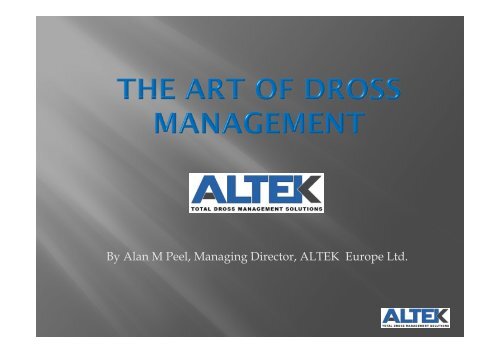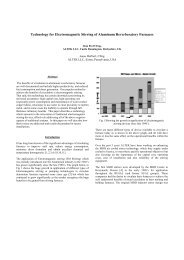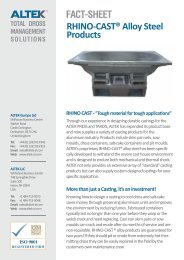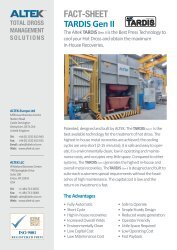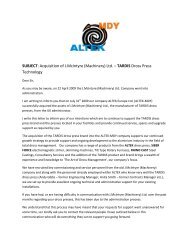You also want an ePaper? Increase the reach of your titles
YUMPU automatically turns print PDFs into web optimized ePapers that Google loves.
By Alan M Peel, Managing Director, <strong>ALTEK</strong> Europe Ltd.
• What is Melt Loss ?<br />
• Main generators <strong>of</strong> melt loss<br />
• Ways to minimise melt loss,<br />
• will focus on furnace stirring<br />
i<br />
• Dealing with the consequence – DROSS<br />
• Economics <strong>of</strong> dross<br />
• Conclusions
DROSS !!
• Looked upon as the unfortunate evil <strong>of</strong> the<br />
industry<br />
• Often, dross is at the bottom <strong>of</strong> the cast<br />
house priority list (LOW PERCEIVED VALUE)<br />
• <strong>The</strong> quality and amount <strong>of</strong> dross generated<br />
can be a good indicator <strong>of</strong> efficiency in the<br />
cast house
• More than 1 million tpy <strong>of</strong> dross is produced<br />
from aluminium cast houses as a consequence<br />
<strong>of</strong> melt loss<br />
• This equates to more than US$ 600 Million<br />
in available aluminium* within the <strong>Dross</strong> !!<br />
* Assuming 60% Al in dross and LME @ $2000/tonne
Cast House Melt Loss
Note 1. Taken from a study <strong>of</strong> Australasian smelter cast houses by Clarke
Scrap would be a much larger<br />
contributor in a re-melt furnace<br />
* Assumes a typical casting furnace in smelter cast house – ‘non re-melt’
• Implementing technology and processes to<br />
minimise melt loss and effectively deal with<br />
DROSS can move you towards industry<br />
BEST PRACTICE...<br />
• Best Practice – Less than 0.6% melt loss*<br />
* Siphoning, 99.9% Al (no alloying), no scrap additions - type <strong>of</strong> operation
• Liquid metal addition (from pot lines)<br />
• Scrap charging g and types <strong>of</strong> scrap addition<br />
• Burner settings and control<br />
• Alloy additions<br />
• Flux additions<br />
• Stirring techniques<br />
• Skimming practice<br />
• Furnace bath temperature control
• Pouring and cascading<br />
develops Al2O3<br />
• Siphoning Sp can reduce<br />
melt loss by > 70%<br />
... A Good Practice
• Most melt loss from<br />
scrap is developed<br />
when exposed to<br />
burners<br />
• Minimise door open<br />
time<br />
• Method <strong>of</strong> filling
Melt Loss - Scrap Type and Quality
Melt Loss - Light Gauge<br />
• Need to submerge/melt<br />
quickly<br />
• Keep away from the<br />
burners<br />
• Use vortex type<br />
charging systems if<br />
possible for light gauge g<br />
scraps<br />
....A Good Practice
• Several melt loss<br />
contributors:-<br />
• O2 mix too rich<br />
• Direct impingement i on the surface/scrap<br />
• Overheating/wicking<br />
<strong>of</strong> the Al
• How is the alloy<br />
added ?<br />
• Need to minimise<br />
i i<br />
door open time
• Skim at the right time<br />
• Minimise Al removal in the<br />
dross<br />
• Ensure consistency<br />
• Minimise i i door open time<br />
• Also minimise wall, sill<br />
damage etc.<br />
• Robotic/Automatic<br />
skimming<br />
.....A Good Practice
Managing g Bath Surface<br />
Temperature
782°C<br />
<strong>The</strong> Temperature <strong>of</strong> the metal is the single most controllable factor that<br />
determines dross generation in a furnace.
Flue Losses<br />
Heat Repelled by Bath:<br />
• Higher Flue Losses<br />
• Higher Refractory Temp.<br />
Total Heat<br />
Supplied<br />
Wall Losses<br />
Radiation<br />
Q_rad_wall<br />
Q_rad_gas<br />
Q_rad_reflected<br />
To Bath<br />
Conduction + convection
Bath Heat Transfer – <strong>The</strong>rmal resistance<br />
<strong>The</strong>rmal Resistance vs Residence Time<br />
<strong>The</strong>rmal Re<br />
sistance [C/W W]<br />
20<br />
16<br />
12<br />
8<br />
4<br />
Increase Bath<br />
Circulation<br />
0<br />
0 5 10 15 20 25 30 35<br />
Residence Time
• <strong>The</strong>re are many ways to circulate a furnace:-<br />
• Skimming tool<br />
• Porous plugs<br />
• Mechanical pumps<br />
• Electro-magnetic pumps and stirrers<br />
• Permanent Magnet Pumps<br />
Awareness has grown exponentially in the past decade !<br />
<strong>The</strong>y all have different +ve’s and –ve’s
EM Pumps and Stirrers - Market Growth<br />
600<br />
500<br />
EM Side Stirrer - Air<br />
400<br />
PM Pumps<br />
No. <strong>of</strong> units<br />
300<br />
200<br />
100<br />
EM Bottom Stirrer - Air<br />
EM Stirrer (China)<br />
EM Stirrer - Channel<br />
Port Type Stirrer<br />
EM Bottom Stirrer -<br />
Water<br />
EMP System<br />
0<br />
pre 1996 1999 2001 2004 2008<br />
Years
• Non contact<br />
• Ability to move the dross to<br />
assist skimming<br />
• Can switch it on/<strong>of</strong>f as<br />
required during the cycle
• Easy to retr<strong>of</strong>it if there is no<br />
basement<br />
• Similar results to the bottom<br />
• Similar results to the bottom<br />
mounted stirrer
Working through 700mm<br />
Refractory and steel !<br />
HULAMIN, South Africa: 5182 Alloy – 4.5% Mg alloying
• With scissor lift and<br />
electrically driven<br />
trolley serving 2<br />
furnaces with one<br />
bottom mounted EM<br />
stirrer<br />
• Start up May 2011<br />
HYDRO Ardal, Norway: Al Si13 Alloys – 13% Si alloying
Melting Energy Cons. (kWh/T sol .chg)<br />
1000<br />
950<br />
900<br />
850<br />
800<br />
Stirrer<br />
No<br />
750 Yes<br />
700<br />
650<br />
600<br />
550<br />
0 1/6 2/6 3/6 4/6 5/6 1<br />
16% Reduction in energy consumption with EM Stirring
Melting Rate (T solid charge)<br />
17<br />
16<br />
15<br />
14<br />
13<br />
12<br />
Stirrer<br />
No<br />
Yes<br />
11<br />
10<br />
9<br />
0 1/6 2/6 3/6 4/6 5/6 1<br />
20% Increase in melt rate with EM Stirring
Dealing with Cast House<br />
<strong>Dross</strong>
• Maximise in-house metal recovery<br />
• Maximise content <strong>of</strong> aluminium<br />
• Maximise size <strong>of</strong> aluminum particles
Two extremes !!
Advantages<br />
• Improvement on doing nothing!<br />
• Very low tech. No equipment required<br />
Disadvantages<br />
• A long way from potential recoveries<br />
• Dusty & Hazardous to environment<br />
• Hazardous to plant personnel<br />
• Relies on operators<br />
O ll R i<br />
Overall Recoveries<br />
• 20 – 30 %
Latest Technology<br />
Advantages<br />
• Provides good in-house drain (10 – 30%)<br />
• Agglomerates the drops <strong>of</strong> aluminum<br />
• Cools quickly<br />
• Supports logistics <strong>of</strong> skimming many<br />
furnaces<br />
Disadvantages<br />
• One press is not set-up to handle large<br />
fluctuations in dross generation, need size<br />
number to requirements<br />
Recoveries<br />
• 60 – 70 % range
• Today’s dross press<br />
bears little resemblance<br />
to early systems<br />
• Amalgamation <strong>of</strong> the<br />
two leading dross press<br />
technologies in the<br />
world<br />
• Provides the highest<br />
metal recoveries
• <strong>Dross</strong> is skimmed into pans<br />
that are designed to cool<br />
dross and maximize metal<br />
drain<br />
• Placed into dross press where<br />
the free metal is squeezed<br />
into pan below<br />
• Press head remains in the<br />
dross to further cool the<br />
dross to desired temperature
Metallic Size in<br />
Uncompressed<br />
<strong>Dross</strong><br />
Metallic Size in<br />
Pressed <strong>Dross</strong><br />
• Consolidates the fine<br />
particles remaining<br />
within the dross<br />
• Migrate to the outside<br />
surface <strong>of</strong> the dross in<br />
plates<br />
• <strong>The</strong>se plates or skin<br />
encapsulates the dross<br />
preventing further<br />
oxidation <strong>of</strong> dust and<br />
fuming<br />
• Significantly ifi improves<br />
recovery by 5 – 10%
At 1300°C
Immediately after pressing<br />
Prior to pressing at 1300°C<br />
After 5 hours
After 15 minutes<br />
After 3 hours
• Rapid sealing <strong>of</strong> the slag to stop funing<br />
• Capturing all aluminium units to minimise any<br />
further Al losses through continued burning<br />
• Cooled skull (surface to 400°C) after 3 hours<br />
• Easily breaks up due to oxide/Al interfaces in<br />
skull<br />
• Massive reduction in slag cooling time<br />
• Stops fuming and dburning
• Produces approximately 200T/month <strong>of</strong> dross<br />
• Installed a relatively small dross press<br />
• <strong>Dross</strong> pan capacity <strong>of</strong> 250 kg<br />
• Before Press installation:<br />
• In-house recovery: 3%<br />
• Secondary recovery: 35%<br />
• After Installation:<br />
• In-house recovery: 8 - 12%<br />
• Secondary recovery: 40 – 42%
Without <strong>ALTEK</strong> Press:<br />
• In-house Recovery = 3%<br />
• 6 T / Month<br />
• $15,000 / Month $184,750<br />
• Secondary Recovery = 35% ($51,216)<br />
• 67.9 T / Month<br />
$133,534<br />
• $169,750 / Month<br />
With <strong>ALTEK</strong> Press:<br />
• In-house Recovery = 8 - 12%<br />
• 20T/Month<br />
• $50,000 / Month<br />
$234,500<br />
($47,520)<br />
• Secondary Recovery = 40 - 42%<br />
$186,980<br />
• 73.8 T / Month<br />
• $184,500 / Month<br />
$53,446 /month<br />
$641,352<br />
Annually<br />
10%<br />
Improvement
• Production <strong>of</strong> 500 T/month <strong>of</strong> dross<br />
• Customer melts a variety <strong>of</strong> aluminum scrap<br />
• Installed a medium sized dross press<br />
• <strong>Dross</strong> pan capacity <strong>of</strong> 700 Kg<br />
• Before Press installation:<br />
• In-house recovery: 0%<br />
• Secondary recovery: 25%<br />
• After Installation:<br />
• In-house recovery: 5 - 10%<br />
• Secondary recovery: 30 – 37%
Without <strong>ALTEK</strong> Press:<br />
• In-house Recovery = 0%<br />
• 0 T / Month<br />
• $0 / Month $312,500<br />
• Secondary Recovery = 25% (132,000)<br />
• 125 T / Month<br />
$180,500<br />
• $312,500 / Month<br />
With <strong>ALTEK</strong> Press:<br />
• In-house Recovery = 5 - 10%<br />
• 37.5T/Month<br />
• $93,750 / Month<br />
$481,000<br />
($122,100)<br />
• Secondary Recovery = 30 - 37%<br />
$358,900<br />
• 154.9T / Month<br />
• $387,250 / Month<br />
$178,400 /month<br />
$2,140,800<br />
Annually<br />
13% Improvement
Skim Efficiently<br />
Cool immediately to maximise recovery<br />
Process the <strong>Dross</strong> Skull efficiently<br />
i To maximise<br />
Aluminium return<br />
Use a Tilt Type<br />
Rotary Furnace
After the Cast House<br />
....<br />
<strong>The</strong> Secondary <strong>Dross</strong><br />
Processor
<strong>Dross</strong> Skulls need to<br />
be recycled in a Tilt<br />
Type Rotary Furnace<br />
<strong>ALTEK</strong> 16 MT Tilt<br />
Type Rotary Furnace
Materials handling and<br />
segregation<br />
Quality <strong>of</strong> input<br />
Oxide/Al content<br />
Flux considerations<br />
- Salt process<br />
- No salt process<br />
All affect the Aluminium recovery from the dross
Handling the residues/<br />
by-products<br />
Corporate responsibility<br />
<strong>of</strong> the dross generator<br />
- No landfill<br />
- Markets for by yproducts<br />
- Cement<br />
- Steel<br />
- Construction<br />
- Flux
• Look at the whole process <strong>of</strong> melt loss to dross<br />
generation to dross recovery<br />
• <strong>The</strong>re is a breadth <strong>of</strong> products to support a correct focus<br />
on Total <strong>Dross</strong> <strong>Management</strong> at each step..<br />
• It starts in the furnace but every step is important..<br />
• Its is very important to understanding the whole process<br />
• <strong>The</strong>re are HUGE financial and environmental<br />
consequences from ignoring effective dross management
• 430 <strong>Dross</strong> Presses<br />
• 45+ Tilt Type Rotary Furnaces<br />
• 48 Electromagnetic Stirrers<br />
• 1000+ dross pans and castings
REMEMBER – <strong>The</strong>re is BIG value in your DROSS !!


